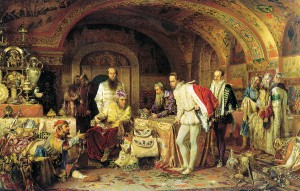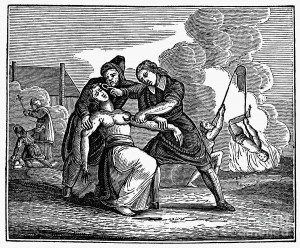Dying and death through the eyes of our ancestors | the path to salvation
This article is geographically focused on Central Europe, specifically on the history of the Kingdom of Bohemia.
Everything that is born one day also dies one day. The inevitability of the end was one of the commonplaces of human existence in the times of our ancestors. As our present time relegates our mortality to the sidelines, many of us may feel that death and decay do not concern them.
In this article, we'll look at what the ideal death looked like, and who our ancestors thought could go to heaven. As you will see, the image and view of what awaits those concerned after death, for example, was quite different in the early modern period from our current ideas.

This whole article would not have been written if it were not for Marie Koldinsky's book, The Everyday Life of a Renaissance Aristocrat. It is from that book that we take the insights from which we compose this text.
Contemporary democratic society generally understands heaven (i.e., those who believe in it) as a place where all are equal. Where no one feels hardship or pain, and where all coexist in mutual community. The devout then add the all-important point that it is a place where they will share eternity in God's favor.
In the days when our country was not yet a democracy and called itself a kingdom, the view of heaven was in some points quite different from ours. There was a hierarchy with God and Jesus Christ at the top. It was to Him that the prayers of many dying were directed.

And dying is a very interesting subject. For the ideal death had a certain form that the dying had to undergo. And that was to die in the circle of the nearest and dearest (not alone). To have all earthly matters settled, and if you were Catholic, to confess to a priest and then receive the sacrament of the altar and last rites. If you were a Protestant, you devoted yourself to prayers in the presence of the cleric until your death. In this way you died with the certainty that after death you would have that longed-for salvation. And the vision of paradise, of course, shaped the dying man's last words to his loved ones. These can now take the form of belonging to a loved one even after death. Reuniting on the other side and sharing eternity together. But this is a far cry from how our ancestors saw it.
The devotions of the time gave the last farewell a quite different form, such as the message of the dying Markéta Zajíc of Minstrberk to her husband, Jan Zajíc of Házmburk, who wrote down her alleged last words in his diary.
"Well, my dearest sir, I already take forgiveness from you and thank you for being kind to me for more than thirty years and treating me in a conjugal manner. May the Lord God repay you abundantly here on earth in long and good health with our dear children and after death in eternal life. For that all of you, my dear sir, may know that I am already taking another husband, whom, as a sign of his innocent death, I embrace here. He shall be my husband for ever. With this I bless you, and commit my body to the earth, and my soul to my dear bridegroom."[1]

The surrender of one's soul to Jesus was probably one of the typical images of life after death. Already during her earthly life, in the correspondence of Anna Salomena Hradiště of Hořovice, we find a sincere declaration of fervent love for her husband, Heřman Černín of Chudenice, which takes the form of a declaration of love first to God and then to her husband.
Contemporary society might take such messages offensively, but at least in the late Renaissance and early Baroque periods it was a typical and sincere form of declaring love to another person.
Religiosity sincerely lived is one of the inseparable forms of life of our ancestors. Today we doubt whether Jesus or God even exists or existed. But the society of that time took it for granted and doubted at most whether their contemporary society was correctly interpreting the scriptures, which to them were clear evidence of the authenticity of the faith itself.
Death itself was to take a social (the presence of family) and spiritual (prayer, last rites) form. But of course this form of death could not always occur.

In 1571, the Bohemian kingdom was shaken by the murder of the knight Ludvík Lorecký of Lkouš and his two sons at the hands of their own subjects. This type of violent death had far worse consequences in those days than murder today. The murder victim did not receive the last rites and confession of his sins. They died unprepared and their souls therefore had little chance of salvation. The punishment for this, therefore, had to fit the offense (which, of course, involved setting a deterrent example for the subjects so that they would know what would happen if they wronged their masters). And when the perpetrators were finally caught, they experienced all the horrors that early modern society of the time had to offer. Tearing off fingernails and finger links with red-hot tongs, cutting the skin and skinning it alive in places where it did not endanger the life of the executed (the back), slow burning, being impaled on a stake, being dragged into a wheel and quartered alive.
Another interesting extreme from our contemporary point of view was, for example, the death of newborns.

Infant deaths were commonplace just a few hundred years ago. And people interpreted them (like other aspects of life) as God's will. It was part of the colour of life then that the moment of birth was one of those thrilling moments in life when the life of both mother and child was decided. But even after the birth, the newborn was not won. Salvation awaited them only if they lived to baptism. If not, limbus awaited them. That is, a place that did not belong to paradise, but where the children could live happily without pain and hardship side by side. It wasn't hell, but it wasn't heaven either.
When in 1643 the wife of Bernard Ignatius of Martinice gave birth to a son, Ferdinand Jaroslav, his father thought that the newborn was too weak and would not survive to baptism. So he used his experience as a canon and baptized the child himself. When it actually died, its parents could at least console themselves with the belief that they had done all they could to save it. [2]
Quite simply, as we said in the introduction, death through the eyes of our ancestors was a natural part of life, but it was also experienced, often differently because of its religious dimension. How exactly we can already surmise and approximate this fact as closely as possible through the writings of the time. The fact remains that death itself is a reflection of the way of life that our ancestors led at that time. A far more religiously active life, which also shaped their views of the world around them, which we now perceive in a different context.
author: Ondřej Bezouška
correction by Kateřina Běhanová
[1] Jaroslav PÁNEK (ed.), Memoirs of a Czech Nobleman from the Mid-16th Century. "Sarmacie" by Jan Zajíc of Házmburk, FHB 14, 1990, p. 66.
[2] Josef HEJNIC (ed.) Bohuslav Balbín, Memorial Inscription to Bernard Ignác of Martinice, Prague 1988, p. 25.

